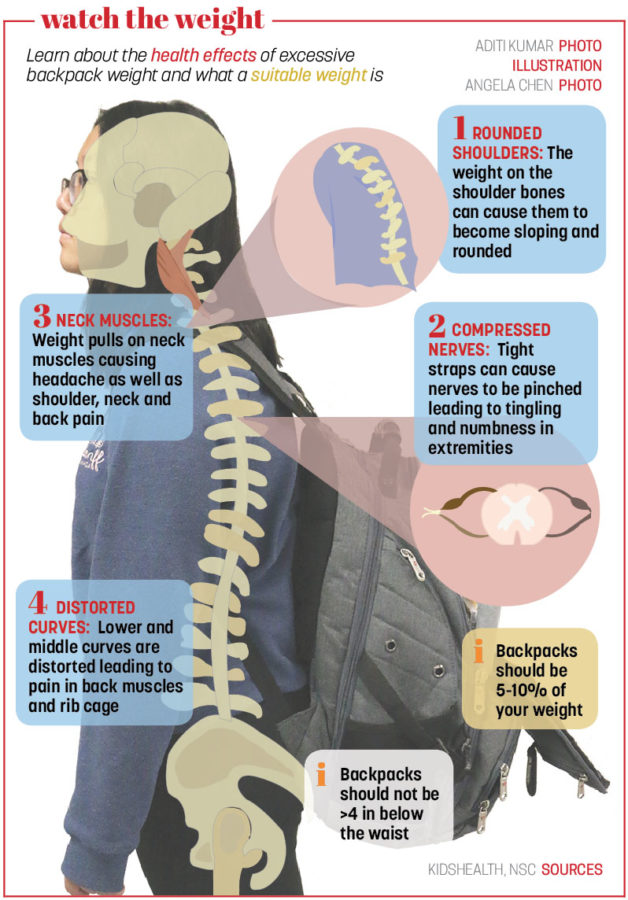For CHS students, backpacks are an essential part of their life, as carrying a backpack all day can be more convenient than putting textbooks in a locker, but according to a survey conducted by Consumer Reports, the average high school student’s backpack weighs 18.4 pounds, which can lead to problems. Sophomore Emma Xiao has a backpack that weighs at least 20 pounds. Due to her heavy backpack, Xiao said she deals with lumbar spondylosis, the tearing of spinal disks, but more specifically for Xiao, a fractured vertebrae.
“Although tennis and viola contributed to my condition, it was mainly wearing my backpack every day that caused the tip of my rib to fracture,” Xiao said. “Because my locker wasn’t very accessible, I usually had three textbooks in my backpack as well as notebooks and binders.”
In fact, back, neck and shoulder pain are common among students due to the weight of their backpacks. According to the U.S. Consumer Product Safety Commission, at least 14,000 children are treated for backpack-related injuries every year. Health teacher Adam Havice said he agrees that back pain is a common issue among students.
“There’s more lower back injuries than any other form of injury in the United States, but there are so many solutions to limiting many injuries,” Havice said. “One solution, which is a great one, is that a lot of our books are going electronic, so that should eliminate heavy textbooks.”

Rolling backpacks have been another possibility to help limit backpack weight on shoulders and prevent injuries. Senior Abby Kaufman brought a rolling backpack to school for a week to try to alleviate her heavy backpack issues.
“My backpack can get so heavy, and one time I was talking to my business teacher, and he told me to set my backpack down because it looked like it was going to break me in half,” Kaufman said. “So that’s when I decided I would bring my rolling backpack to school the next day. I found my back was hurting a lot less during that week.”
This problem is not unique to this country. Last November, the government in India announced a new law limiting the weight of school bags depending on a child’s age. Students in grades one and two are allowed to bags weighing no more than three pounds. For grades three and four, the limit is 6.6 pounds, and for grades up to grade 10, the limit is 11 pounds.
Havice said this would be difficult to monitor here at CHS, but the law passed in India is a great idea because if someone is small, they don’t need to be carrying around 100 pounds worth of books, making them prone to injury. Some students athletes have to carry around two backpacks, which is double the weight, giving students more to worry about.
Also, the well-being of students can be affected by overly heavy backpacks. Xiao said the feeling of more weight on her shoulders from her backpack makes her feel more stressed mentally as she said she feels like she has more work to do.
“Physically, (backpacks) obviously affects students’ well-being because of the excess weight on your shoulders, but also it affects students’ mental well-being because if you have a heavy backpack, it feels like you have a lot of work to do even if you don’t,” Xiao said. “An overly heavy backpack mentally adds unnecessary stress which can affect students’ well-being.”

Research has also shown the various physical impacts of carrying heavy backpacks. According to a study in the Archives of Disease in Childhood, researchers accessed the backpacks and back health of 1,403 students from ages 12 to 17. One in four students said they had suffered back pain for more than 15 days the previous year. Scoliosis, the sideways curvature of the spine, accounted for 70% of the pain. The remaining 30% had either lower back pain or contractures: continuous, involuntary muscle contractions.
“When I had the fracture, I had to wear a brace all day, and before I had the brace, every time I sat in a chair I could feel excruciating pain. Luckily, while wearing the brace, I was still able to participate in activities, some people with back pain aren’t as lucky as me,” Xiao said. “Being aware if you (are) having back problems is the best advice I can give for students using heavy backpacks.”
Read an opinion piece about the other health effects related to school, specifically mental health, here.


































![British royalty are American celebrities [opinion]](https://hilite.org/wp-content/uploads/2024/03/Screenshot-2024-03-24-1.44.57-PM.png)



















![Chelsea Meng on her instagram-run bracelet shop [Biz Buzz]](https://hilite.org/wp-content/uploads/2024/04/IMG_2446-1200x838.jpg)
![Review: Quiet on Set: The Dark Side of Kids TV is the long awaited exposé of pedophilia within the children’s entertainment industry [MUSE]](https://hilite.org/wp-content/uploads/2024/04/unnamed.jpg)
![Review: “The Iron Claw” cannot get enough praise [MUSE]](https://hilite.org/wp-content/uploads/2024/04/unnamed.png)
![Review: “The Bear” sets an unbelievably high bar for future comedy shows [MUSE]](https://hilite.org/wp-content/uploads/2024/03/unnamed.png)
![Review: “Mysterious Lotus Casebook” is an amazing historical Chinese drama [MUSE]](https://hilite.org/wp-content/uploads/2024/03/0.webp)
![Review in Print: Maripaz Villar brings a delightfully unique style to the world of WEBTOON [MUSE]](https://hilite.org/wp-content/uploads/2023/12/maripazcover-1200x960.jpg)
![Review: “The Sword of Kaigen” is a masterpiece [MUSE]](https://hilite.org/wp-content/uploads/2023/11/Screenshot-2023-11-26-201051.png)
![Review: Gateron Oil Kings, great linear switches, okay price [MUSE]](https://hilite.org/wp-content/uploads/2023/11/Screenshot-2023-11-26-200553.png)
![Review: “A Haunting in Venice” is a significant improvement from other Agatha Christie adaptations [MUSE]](https://hilite.org/wp-content/uploads/2023/11/e7ee2938a6d422669771bce6d8088521.jpg)
![Review: A Thanksgiving story from elementary school, still just as interesting [MUSE]](https://hilite.org/wp-content/uploads/2023/11/Screenshot-2023-11-26-195514-987x1200.png)
![Review: When I Fly Towards You, cute, uplifting youth drama [MUSE]](https://hilite.org/wp-content/uploads/2023/09/When-I-Fly-Towards-You-Chinese-drama.png)
![Postcards from Muse: Hawaii Travel Diary [MUSE]](https://hilite.org/wp-content/uploads/2023/09/My-project-1-1200x1200.jpg)
![Review: Ladybug & Cat Noir: The Movie, departure from original show [MUSE]](https://hilite.org/wp-content/uploads/2023/09/Ladybug__Cat_Noir_-_The_Movie_poster.jpg)
![Review in Print: Hidden Love is the cute, uplifting drama everyone needs [MUSE]](https://hilite.org/wp-content/uploads/2023/09/hiddenlovecover-e1693597208225-1030x1200.png)
![Review in Print: Heartstopper is the heartwarming queer romance we all need [MUSE]](https://hilite.org/wp-content/uploads/2023/08/museheartstoppercover-1200x654.png)






















![Review: Ladybug & Cat Noir: The Movie, departure from original show [MUSE]](https://hilite.org/wp-content/uploads/2023/09/Ladybug__Cat_Noir_-_The_Movie_poster-221x300.jpg)

![Review: Next in Fashion season two survives changes, becomes a valuable pop culture artifact [MUSE]](https://hilite.org/wp-content/uploads/2023/03/Screen-Shot-2023-03-09-at-11.05.05-AM-300x214.png)
![Review: Is The Stormlight Archive worth it? [MUSE]](https://hilite.org/wp-content/uploads/2023/10/unnamed-1-184x300.png)


